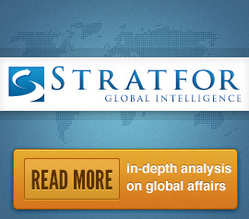Stratfor regularly highlights countries that the media overlooks but that are nevertheless geopolitically important. Poland and Azerbaijan are good examples. Poland, especially if Russia can undermine the independence of Ukraine, is the bellwether state of Central-Eastern Europe. Western-leaning Azerbaijan, wealthy in hydrocarbons, adjoins Iran and is the potential political heartland of Iran's powerful Azeri Turk minority. Oman, at the southeastern tip of the Arabian Peninsula, also belongs in this category. Indeed, the Greater Indian Ocean will be the maritime organizing principle of the 21st century world, and perhaps no country (other than India itself) sits astride it more than Oman. Remember that the Arabian Sea -- the entire western half of the Indian Ocean -- used to be called the Sea of Oman.
Oman occupies the most central maritime transshipment point between the Indian subcontinent and Africa, the two regions of the world that will see the largest population growth and perhaps the largest growth of middle classes in coming decades. Oman, moreover, is geographically situated between Iran and Saudi Arabia, the two great rival sectarian states in the Muslim Middle East. Not surprisingly, Oman has often served as a quiet, diplomatic go-between for Iran and the United States.
Oman's diplomatic value underscores how its locational advantages are amplified by its political ones. In Sultan Qaboos bin Said al Said, Oman quite simply has the best educated and among the most enlightened leaders in the Arab world. He is an absolute ruler with sophisticated liberal values. When the Arab Spring led to sustained protests in the capital of Muscat, Sohar and other Omani cities, Qaboos deftly allowed the demonstrations to proceed, then strengthened the role of the elected Shura Council, replaced older ministers with young ones, arrested some of the protest leaders and in general maneuvered in such a way that while the authorities were heavily criticized, his own prestige and power were largely unaffected. Thus, he has emerged from the Arab Spring in a comparatively stronger position vis-a-vis other leaders in the Middle East.
Oman now finds itself in the difficult but enviable position of being able to concentrate on the ultimate challenge of modern societies: building responsive and transparent institutions that ultimately make the role of the ruler himself less paramount. Of course, this is the task of societies throughout the Middle East, but few can conduct this experiment under such advantageous conditions as Oman: A country with a deeply respected ruler who is not under political siege, and who also has access to hydrocarbon revenues for at least another decade or so.
Certainly, Oman's political transition is not without grave risks. Sultan Qaboos is in his 70s and in uncertain health, without an obvious successor. Nevertheless, stability, like power itself, is relative. And relatively speaking, Oman's political prospects look brighter than many other places in the Arab world. Therefore, given Oman's reasonably secure political outlook, let's look more closely at geopolitical and geo-economic developments here.
Oman is taking advantage of its Indian Ocean centrality by building and enlarging a network of ports -- Salalah, Duqm, Muscat and Sohar. Salalah, in the southwestern province of Dhofar -- close to the border with Yemen -- has the advantage of ultra-transshipment centrality between India and Africa and between the Persian Gulf and the Red Sea. In the world of container traffic, Salalah already is a transshipment point for the entire navigable, southern rimland of Eurasia from northeastern Asia to East Africa and the Suez Canal. Salalah's expected further expansion will benefit from this fact. Salalah, moreover, lies safely outside the Persian Gulf -- as, especially, does Sohar at the other end of Oman, close to the Strait of Hormuz.
There are plans to link Sohar and Salalah by road, rail and perhaps even pipelines to ports in the United Arab Emirates (like Jebel Ali) and as far north as Kuwait. Were there ever a military cataclysm in the Gulf -- inside the Strait of Hormuz, that is -- Omani ports could figure more prominently.












